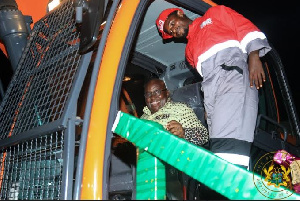Government is digitising the Kpong Left Bank Irrigation Project with an automation system to enable it to demand due payments from commercial farmers for water used for irrigation on their farms.
The 35 million-dollar World Bank funded project, expected to cover 2000 hectares of land, would enable the project scheme managers to monitor the level of water in the supply canals and the quantity of water that farmers use for irrigation so that they could be charged the right amount of fees.
The project, implemented under the Ghana Commercial Agriculture Project (GCAP) of the Ministry of Food and Agriculture, is focused on more than 1000 farmers who produce rice, maize and vegetables for commercial purposes.
When completed, it would be the third largest irrigation project in the country after the Tono Water project in the Upper East Region and the Kpong Irrigation Scheme Project.
Project Coordinator of the GCAP, Osei Owusu-Agyemang, said the project is aimed at getting the farmers to farm throughout the year without having to encounter problems like lack of access to water for irrigation.
He said the farmers would also be trained to employ best agronomic practices and be connected to markets to increase productivity and generate more profit.
Mr Owusu-Agyemang noted that a law had been passed in parliament to ensure that commercial farmers join Water Users Association and pay for the water used on their farms, therefore they had no reason to avoid payments.
“Previously, farmers were paying by the number of hectares or size of lands they had which was not fair. This system will charge them according to the number of litres they use to irrigate their farms,” he said.
The project, which is 63 per cent complete, would be fully completed in December, he disclosed.
As Ghana promoted the consumption of its own foods, he said, it was necessary to boost the production of rice, maize and vegetables, to reduce the rate of importation and enhance Ghana’s space in the capital market.
A Contract Management Specialist for GCAP, Mr Philip Daniel Laryea, said the objective of rolling out the project was to rehabilitate and expand the formerly existing 450 hectartes of farm lands into 2000 with additional canals.
To ensure the safety of farmers, he said, safety ladders would be put at vantage points in the canal to save farmers who might accidentally fall into the deep sides of the canal
Warning signs would also be placed within the project areas with inscriptions in English and local languages to put users of the area out of danger.
Mr Laryea said for farmers to fully utilise the irrigation project, they needed to have access to roads connecting the project to farms and communities.
He gave assurance that they would therefore construct 180 kilometre roads with gravel surfaces, drains and culverts to allow easy access to the project.
The Project Manager of Mechatronics Systems PVT Limited, the engineering company working on the project, Santosh Raut, said the automation system had a remote terminal unit connected to a system called gate measurement systems in the canals with internet connections, solar charges and batteries.
He explained that when the machine is activated, that farmers who needed water supply, would immediately get it pumped onto their farms.
With two independent networks which ensured continuity of operation at all times, he said, the operating office had database, hosted on websites to enable them to know what was happening from across the country.
“At first, we had to contract people to monitor and tell us what was happening at every work station as well as how farmers were using the water. But with the new system, we can know when farmers need water, the level of water in canals, and what quantity of water farmers need by monitoring their operations on our system,” he said.
Although the automation system was reliable, he said the manual system of pumping water onto farms would be maintained for any future emergencies.


Comments are closed.